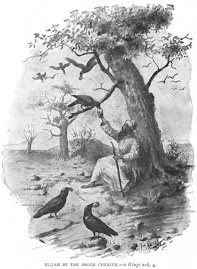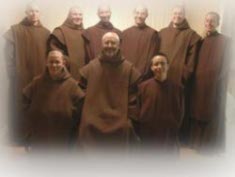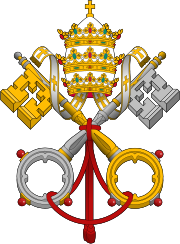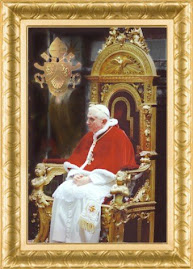
Fragments from "Mary in Our Life" by Fr William G Most. Part 2
There are higher forms of contemplation in the illuminative way, which follows after the first night. The most characteristic prayer of the illuminative way is the prayer of quiet, in which the presence of God is felt experimentally, and with great pleasure (19). The soul seems to be immersed in God, saturated with Him, so that it has an obscure but very perceptibly real contact with Him -as real as that of a hand laid on the table. The feeling seems first to fill the soul itself, and then to overflow on the body. At the same time, the soul feels as it were bound, so that it is impeded more or less from producing the interior acts that it ordinarily would make at will during prayer (20). In fact, the person may fear to move at all, lest it hinder this wondrous pleasure (21). Yet distractions in the intellect and in the imagination are not only possible but are not rare during the prayer of quiet, for the divine action is holding captive only the will, not the other faculties (22). At first the prayer of quiet usually appears only occasionally, and for but a few moments at a time-perhaps for the length of a Hail Mary. In some, this great grace appears abruptly, and when they are not expecting it. They are suddenly seized with an unusual recollection which they cannot help noticing. The divine seems to penetrate them. They remain motionless-and then, as suddenly as it came, it vanishes. But in others these graces appear to come gradually. The intensity of the prayer also varies from time to time. After the first appearance of this grace, it may not be experienced again for a long time-even for a period of years; such interruptions may be due to the infidelities of the soul receiving it. In other cases the prayer does not suffer such prolonged interruptions: it becomes more and more frequent, and the soul reaches a state in which quietude is habitual. This sweetness may last for a long period, and may come even outside the time of prayer: any mention of God may be enough to invite it (23).
After the illuminative way there follows the more terrible-and much more rare-purgation of the second passive night, the night of the spirit. This leads into the unitive way, with its higher forms of contemplation, in which not only the will but all the faculties are taken captive by the divine action. There are some souls, such as St. Thérèse, in whom contemplation seldom appears in a sweet form: most of their contemplation is in an arid form.24 St. Thérèse must have liked to think that Mary herself walked in this largely (if not entirely) arid way. This thought emerges in her poem, "Why I Love You, O Mary":
I know that at Nazareth, Virgin full of graces,
You lived in great poverty, not wishing anything more;
No raptures, no miracles, no ecstasies
Embellished your life, O Queen of the elect.
The number of little ones is very great upon the earth
They can, without trembling, lift up their eyes to you.
It pleases you to walk along the common way,
Incomparable Mother, to guide them to the heavens.
Whatever may be the truth as to the aridity or sweetness of Mary's contemplation, it is certain that she passed far beyond the level accessible to any other saint (25). All authors agree that infused contemplation is something that a soul cannot procure for itself, not even with the help of the usual actual graces. It is received only when God Himself chooses to give it. When it is given, it comes by a special inspiration of the Holy Spirit, received through the Gifts of the Holy Spirit. But is this infused contemplation normal? It is not normal in the sense of being found in many persons. That much is dear. But is it part of the theoretically normal development for souls? The answer is hotly disputed. The view of such theologians as Gabriel of St. Mary Magdalen and Garrigou-Lagrange( 26) seems far more probable: that it is theoretically normal, and that therefore every soul may legitimately desire to attain it. But in such a desire two points are to be observed: first, it should not be desired as an end in itself, but as a means of union with God; and, second, it is best that the soul refrain from desiring the arid or the sweet forms as such: that decision should be completely surrendered to God through the hands of Mary.
Is it possible to arrive at sanctity without infused contemplation? Again, as Fr. Gabriel and Garrigou-Lagrange think, the answer seems to be No. But there are authors who insist that a soul may develop in other ways, by other paths, and so come even to great sanctity without infused contemplation. Such is the opinion of G. Bélorgey, (27) A. Poulain, (28) A. Tanquerey,(29) and some others. It is true that St. Teresa of Avila states that some persons arrive at sanctity without contemplation (30). But, as Fr. Gabriel well shows, she has in mind contemplation of an experimentally felt, sweet kind (31). She does not seem to think of the arid forms. Some saints, as we have already said, seem to have received most, if not all, of their contemplation in hidden or arid forms (32).
It is good for us to keep this ideal of contemplation before our eyes, even in the knowledge that the majority of souls will never attain it. Actually a considerable number of souls do reach it: it is known to occur not only in monasteries, but even among simple lay persons in rural districts, and among working girls in large cities. The very knowledge of its possibility is a useful stimulus to generosity. It is also good to know the direction in which meditation aims, for the light which that knowledge sheds on the normal course of development. For all of us can hope that meditation will gradually become simplified for us, moving toward contemplation, even if we do not reach it.
It is with reluctance that we have refrained from the mention of Mary's role during the description of contemplation. This procedure was suggested by the fact that there are still problems on the role of Mary in contemplation which theologians have not completely solved. Some things are quite clear. We know that Mary herself is undoubtedly the great model of contemplative souls, for her contemplation reached to heights far beyond the reach of the ordinary saints. We know that it is through her that even the graces of contemplation are given to souls, for she is the Mediatrix of all graces, without exception. It is likewise clear that even souls whose spirituality is not of the more intimate Marian form often enjoy her association during the illuminative and unitive ways, as well as in the purgative way (33). In fact, in souls whose every act is guided and moved by the Holy Spirit in the unitive way, their very love of Mary is produced in them by the action of the Holy Spirit (34). But souls especially devoted to Mary report particular kinds of favors in which Mary's presence is felt in a remarkable way. Thus St. Thérèse reports an experience in which: "It was as if a veil had been thrown over me hiding all the things of earth.... I seemed to be entirely hidden beneath the veil of the Blessed Virgin.... I remained in this state for an entire week" (35). And again the same saint, during the terrible dark night in which she spent the last part of her life, when she was asked: "Have they succeeded in hiding the Blessed Mother, too?" answered: "No, the Blessed Virgin will never be hidden from me, for I love her too much for that to happen" (36). But the really difficult problem concerns the consciousness of the presence of Mary at the very moment in which infused contemplation is being given to a soul (37). A considerable number of Marian souls have reported just such an experience: but the information they have given is, for the most part, so scant that it is difficult to construct a complete theological explanation (38).
Whatever the answer to the above-mentioned problems may be, it is certain that if we are faithful to Mary, she will make our meditation more fruitful and our progress more rapid. Furthermore, although the grace of contemplation is rare, yet a most faithful practice of the perfect devotion to Mary (which we shall explain in chapter XVIII) will give to all a better chance of reaching it, for Mary makes the path through the dark night of sense much easier and more rapid (39).
END NOTES
19 See Poulain, op. cit., pp. 220-34; St. Teresa of Avila, Autobiography, XIV-XV (I, 83-96); Way of Perfection, XXXI (II, 126-34); Interior Castle, IV, ii (II, 236-39); Bélorgey, op. cit., pp. 120-58; and Garrigou-Lagrange, op. cit., II, 300-3.
20 This phenomenon is called ligature. In regard to it, during prayer the soul should not force any acts, though it may make those acts for which it feels a facility; outside of prayer the soul should use its freedom. On ligature see Poulain, op. cit., pp. 178-99, and Belorgey, op. cit., pp. 125-26.
21 Slight and brief movement does not cause the prayer to leave, but much movement would drive out the prayer. See Poulain, op. cit., pp. 167-69.
22 Although the will alone is held captive, yet the other faculties are not excluded entirely: they should still be united to God. See Poulain, op. cit., pp. 130-31. On distractions, see St. Teresa of Avila, Way of Perfection XXXI (II, 130), and Autobiography, XIV (I, 84).
23 On the distinction of this prayer from the prayer of simplicity, see Poulain, op. cit., pp. 222-30, and pp. 64-199 (esp. 64-65, 90-91, and 114). See also St. Teresa of Avila, Interior Castle, IV, ii.
24 See Gabriel of St. Mary Magdalen, op. cit., pp. 95 and 97; and Garrigou-Lagrange, op. cit., II, 634-37.
25 See L. Reypens, "Marie et la Mystique," Du Manoir, Maria, I, 747-63.
26 To the casual reader, these two authors will seem to be at opposite poles. While there is great difference in their use of terms, there is actually only a rather small difference in their meaning. See the comparison given in The Three Ages of she Interior Life, II, 349, n. 28, and 548, n.3.
27 Bélorgey, op. cit., pp. 99-101.
28 Poulain, op. cit., pp. 522 ff.
29 Tanquerey, The Spiritual Life, pp. 731-37. Tanquerey, in opposition to the school of Gabriel of St. Mary Magdalen and Garrigou-Lagrange, holds that the first night comes at the beginning of the "mystic unitive way," not at the beginning of the illuminative way. He recognizes that St. John of the Cross (Dark Night, I, viii) states that the night of sense comes to beginners (i.e., at the end of the purgative way, according to our view). But Tanquerey thinks that St. John's term "beginners" designates beginners in the mystical forms of prayer, or what he calls the mystical unitive way (for Tanquerey also speaks of the "simple unitive way," in which is found the prayer of simplicity). Garrigou-Lagrange answers this argument (op. cit., II, 42, n.8) by showing that the list of faults which St. John of the Gross (Dark Night, II, i-vii) ascribes to his "beginners" would not fit anything but a very watered-down version of the unitive way.
30 St. Teresa, Way of Perfection, XVII.
31 Gabriel of St. Mary Magdalen, op. cit., p. 111.
32 See note 24 above.
33 See St. Teresa of Avila, Interior Castle, VI, vii; and Bélorgey, op. cit., pp. 134-35.
34 See chap. XIX.
35 Novissima Verba, trans. Carmelite Nuns of New York (New York, 1952), p. 42.
36 Ibid., p. 35.
37 There is even a problem in reference to the thought of the Sacred Humanity of Christ during the arid night. See Gabriel of St. Mary Magdalen, The Spiritual Director, trans. a Benedictine of Stanbrook Abbey (Westminster, 1951), pp. 109-14. See also note 19, chap. XII above.
38 See V. Hoppenbrouwers, O.Carm., "The Blessed Mother Teaches Us to Pray," Analecta Ordinis Carmelitarum, XVI (1951), II, 259-65, L Reypens, "Marie et la Mystique" Du Manoir, Maria, I, 760-63; Ven. Michael of St. Augustine, "The Mariform and Marian Life, in Mary, for Mary," McGinnis (ed.), Life with Mary; and Bélorgey, op. cit., p. 107. See also Marie-Eugène de l'Enfant-Jésus, O.C.D., "La decouverte de la Sainte Vierge," Marie (Nicolet, P.Q.), November-December, 1952, pp. 70-72; and Jean de Jésus-Hostie, O.CD., "Notre-Dame des nuits," ibid., pp. 77-79.
39 See Garrigou-Lagrange, Christian Perfection and Contemplation, pp. 386-87.
after www.catholicculture.org
After the illuminative way there follows the more terrible-and much more rare-purgation of the second passive night, the night of the spirit. This leads into the unitive way, with its higher forms of contemplation, in which not only the will but all the faculties are taken captive by the divine action. There are some souls, such as St. Thérèse, in whom contemplation seldom appears in a sweet form: most of their contemplation is in an arid form.24 St. Thérèse must have liked to think that Mary herself walked in this largely (if not entirely) arid way. This thought emerges in her poem, "Why I Love You, O Mary":
I know that at Nazareth, Virgin full of graces,
You lived in great poverty, not wishing anything more;
No raptures, no miracles, no ecstasies
Embellished your life, O Queen of the elect.
The number of little ones is very great upon the earth
They can, without trembling, lift up their eyes to you.
It pleases you to walk along the common way,
Incomparable Mother, to guide them to the heavens.
Whatever may be the truth as to the aridity or sweetness of Mary's contemplation, it is certain that she passed far beyond the level accessible to any other saint (25). All authors agree that infused contemplation is something that a soul cannot procure for itself, not even with the help of the usual actual graces. It is received only when God Himself chooses to give it. When it is given, it comes by a special inspiration of the Holy Spirit, received through the Gifts of the Holy Spirit. But is this infused contemplation normal? It is not normal in the sense of being found in many persons. That much is dear. But is it part of the theoretically normal development for souls? The answer is hotly disputed. The view of such theologians as Gabriel of St. Mary Magdalen and Garrigou-Lagrange( 26) seems far more probable: that it is theoretically normal, and that therefore every soul may legitimately desire to attain it. But in such a desire two points are to be observed: first, it should not be desired as an end in itself, but as a means of union with God; and, second, it is best that the soul refrain from desiring the arid or the sweet forms as such: that decision should be completely surrendered to God through the hands of Mary.
Is it possible to arrive at sanctity without infused contemplation? Again, as Fr. Gabriel and Garrigou-Lagrange think, the answer seems to be No. But there are authors who insist that a soul may develop in other ways, by other paths, and so come even to great sanctity without infused contemplation. Such is the opinion of G. Bélorgey, (27) A. Poulain, (28) A. Tanquerey,(29) and some others. It is true that St. Teresa of Avila states that some persons arrive at sanctity without contemplation (30). But, as Fr. Gabriel well shows, she has in mind contemplation of an experimentally felt, sweet kind (31). She does not seem to think of the arid forms. Some saints, as we have already said, seem to have received most, if not all, of their contemplation in hidden or arid forms (32).
It is good for us to keep this ideal of contemplation before our eyes, even in the knowledge that the majority of souls will never attain it. Actually a considerable number of souls do reach it: it is known to occur not only in monasteries, but even among simple lay persons in rural districts, and among working girls in large cities. The very knowledge of its possibility is a useful stimulus to generosity. It is also good to know the direction in which meditation aims, for the light which that knowledge sheds on the normal course of development. For all of us can hope that meditation will gradually become simplified for us, moving toward contemplation, even if we do not reach it.
It is with reluctance that we have refrained from the mention of Mary's role during the description of contemplation. This procedure was suggested by the fact that there are still problems on the role of Mary in contemplation which theologians have not completely solved. Some things are quite clear. We know that Mary herself is undoubtedly the great model of contemplative souls, for her contemplation reached to heights far beyond the reach of the ordinary saints. We know that it is through her that even the graces of contemplation are given to souls, for she is the Mediatrix of all graces, without exception. It is likewise clear that even souls whose spirituality is not of the more intimate Marian form often enjoy her association during the illuminative and unitive ways, as well as in the purgative way (33). In fact, in souls whose every act is guided and moved by the Holy Spirit in the unitive way, their very love of Mary is produced in them by the action of the Holy Spirit (34). But souls especially devoted to Mary report particular kinds of favors in which Mary's presence is felt in a remarkable way. Thus St. Thérèse reports an experience in which: "It was as if a veil had been thrown over me hiding all the things of earth.... I seemed to be entirely hidden beneath the veil of the Blessed Virgin.... I remained in this state for an entire week" (35). And again the same saint, during the terrible dark night in which she spent the last part of her life, when she was asked: "Have they succeeded in hiding the Blessed Mother, too?" answered: "No, the Blessed Virgin will never be hidden from me, for I love her too much for that to happen" (36). But the really difficult problem concerns the consciousness of the presence of Mary at the very moment in which infused contemplation is being given to a soul (37). A considerable number of Marian souls have reported just such an experience: but the information they have given is, for the most part, so scant that it is difficult to construct a complete theological explanation (38).
Whatever the answer to the above-mentioned problems may be, it is certain that if we are faithful to Mary, she will make our meditation more fruitful and our progress more rapid. Furthermore, although the grace of contemplation is rare, yet a most faithful practice of the perfect devotion to Mary (which we shall explain in chapter XVIII) will give to all a better chance of reaching it, for Mary makes the path through the dark night of sense much easier and more rapid (39).
END NOTES
19 See Poulain, op. cit., pp. 220-34; St. Teresa of Avila, Autobiography, XIV-XV (I, 83-96); Way of Perfection, XXXI (II, 126-34); Interior Castle, IV, ii (II, 236-39); Bélorgey, op. cit., pp. 120-58; and Garrigou-Lagrange, op. cit., II, 300-3.
20 This phenomenon is called ligature. In regard to it, during prayer the soul should not force any acts, though it may make those acts for which it feels a facility; outside of prayer the soul should use its freedom. On ligature see Poulain, op. cit., pp. 178-99, and Belorgey, op. cit., pp. 125-26.
21 Slight and brief movement does not cause the prayer to leave, but much movement would drive out the prayer. See Poulain, op. cit., pp. 167-69.
22 Although the will alone is held captive, yet the other faculties are not excluded entirely: they should still be united to God. See Poulain, op. cit., pp. 130-31. On distractions, see St. Teresa of Avila, Way of Perfection XXXI (II, 130), and Autobiography, XIV (I, 84).
23 On the distinction of this prayer from the prayer of simplicity, see Poulain, op. cit., pp. 222-30, and pp. 64-199 (esp. 64-65, 90-91, and 114). See also St. Teresa of Avila, Interior Castle, IV, ii.
24 See Gabriel of St. Mary Magdalen, op. cit., pp. 95 and 97; and Garrigou-Lagrange, op. cit., II, 634-37.
25 See L. Reypens, "Marie et la Mystique," Du Manoir, Maria, I, 747-63.
26 To the casual reader, these two authors will seem to be at opposite poles. While there is great difference in their use of terms, there is actually only a rather small difference in their meaning. See the comparison given in The Three Ages of she Interior Life, II, 349, n. 28, and 548, n.3.
27 Bélorgey, op. cit., pp. 99-101.
28 Poulain, op. cit., pp. 522 ff.
29 Tanquerey, The Spiritual Life, pp. 731-37. Tanquerey, in opposition to the school of Gabriel of St. Mary Magdalen and Garrigou-Lagrange, holds that the first night comes at the beginning of the "mystic unitive way," not at the beginning of the illuminative way. He recognizes that St. John of the Cross (Dark Night, I, viii) states that the night of sense comes to beginners (i.e., at the end of the purgative way, according to our view). But Tanquerey thinks that St. John's term "beginners" designates beginners in the mystical forms of prayer, or what he calls the mystical unitive way (for Tanquerey also speaks of the "simple unitive way," in which is found the prayer of simplicity). Garrigou-Lagrange answers this argument (op. cit., II, 42, n.8) by showing that the list of faults which St. John of the Gross (Dark Night, II, i-vii) ascribes to his "beginners" would not fit anything but a very watered-down version of the unitive way.
30 St. Teresa, Way of Perfection, XVII.
31 Gabriel of St. Mary Magdalen, op. cit., p. 111.
32 See note 24 above.
33 See St. Teresa of Avila, Interior Castle, VI, vii; and Bélorgey, op. cit., pp. 134-35.
34 See chap. XIX.
35 Novissima Verba, trans. Carmelite Nuns of New York (New York, 1952), p. 42.
36 Ibid., p. 35.
37 There is even a problem in reference to the thought of the Sacred Humanity of Christ during the arid night. See Gabriel of St. Mary Magdalen, The Spiritual Director, trans. a Benedictine of Stanbrook Abbey (Westminster, 1951), pp. 109-14. See also note 19, chap. XII above.
38 See V. Hoppenbrouwers, O.Carm., "The Blessed Mother Teaches Us to Pray," Analecta Ordinis Carmelitarum, XVI (1951), II, 259-65, L Reypens, "Marie et la Mystique" Du Manoir, Maria, I, 760-63; Ven. Michael of St. Augustine, "The Mariform and Marian Life, in Mary, for Mary," McGinnis (ed.), Life with Mary; and Bélorgey, op. cit., p. 107. See also Marie-Eugène de l'Enfant-Jésus, O.C.D., "La decouverte de la Sainte Vierge," Marie (Nicolet, P.Q.), November-December, 1952, pp. 70-72; and Jean de Jésus-Hostie, O.CD., "Notre-Dame des nuits," ibid., pp. 77-79.
39 See Garrigou-Lagrange, Christian Perfection and Contemplation, pp. 386-87.
after www.catholicculture.org



























